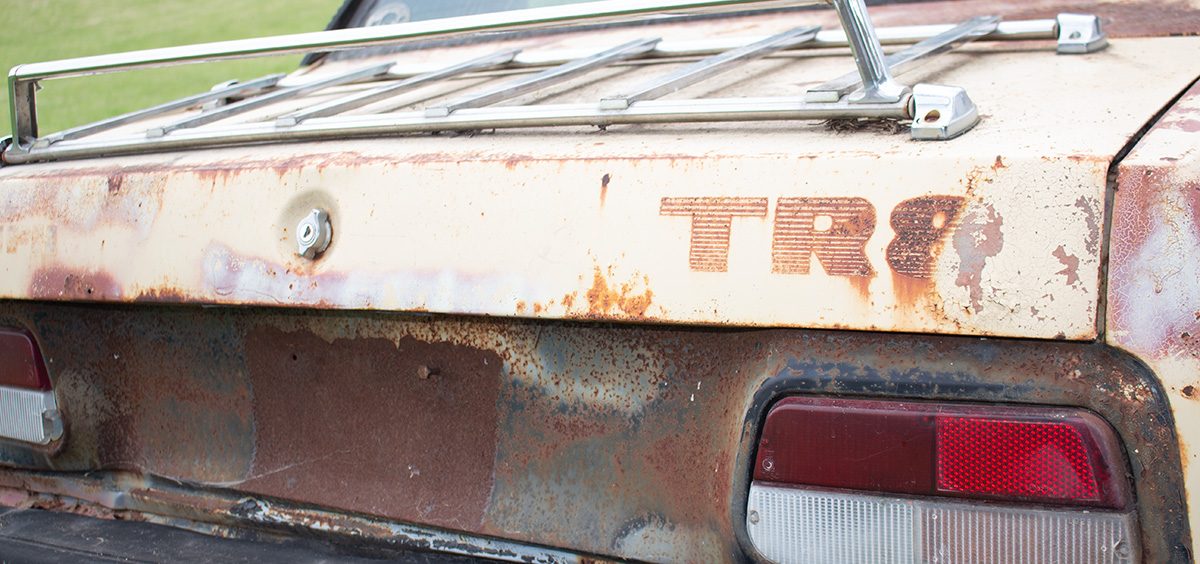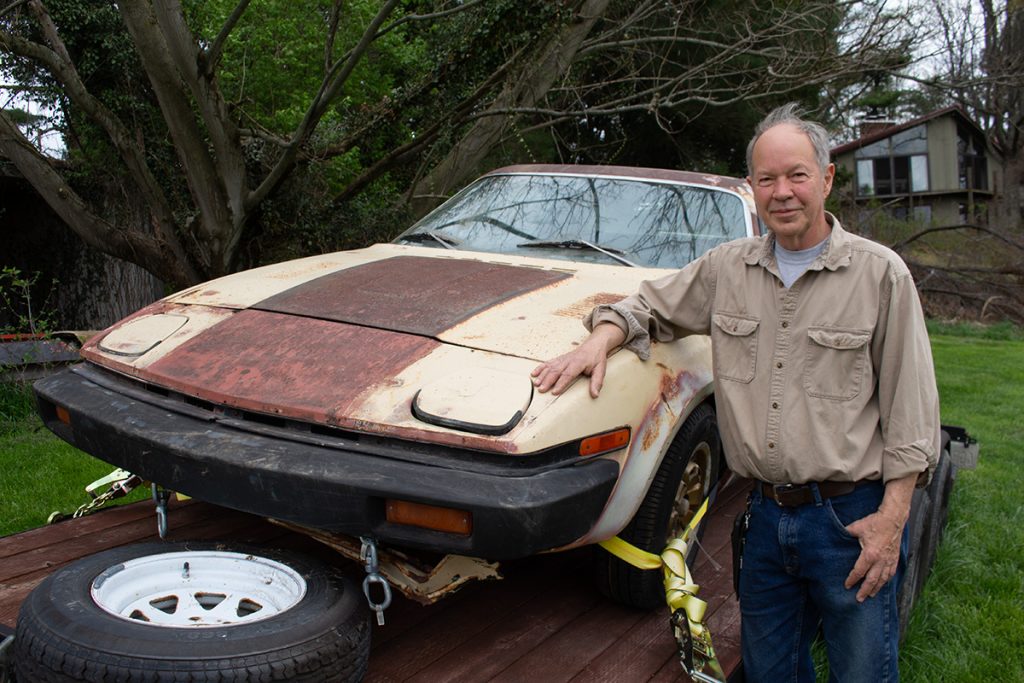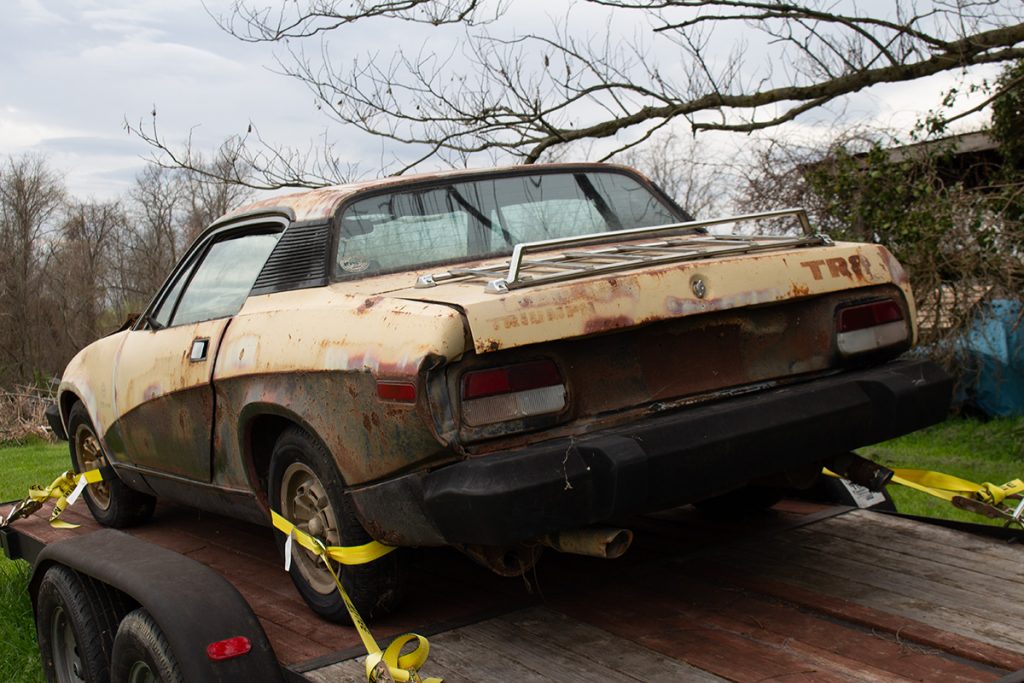News

When he finally found his dream TR8 sports car, he bought it on the spot. It took another two years to prove it was really his
By: David Forster
Posted on:
ATHENS, Ohio (WOUB) — Chris Schermacher sat in the courtroom with his attorney. It had taken two years of jumping through bureaucratic hoops to get to this point.
And now a judge would finally determine whether he was the rightful owner of a car that doesn’t run, has little value and would require a lot of time and effort to get back on the road.
Schermacher was a brand-new second lieutenant in the Marine Corps stationed in Quantico, Virginia, in the mid-1970s when he first set eyes on a TR7.
“There was a Triumph dealership right outside the main gate,” he said. “So when you left, you kind of looked at these cars and went, ‘Damn, those are pretty nice.’”
The TR7 was introduced in 1974 with an advertising campaign billing it as “the shape of things to come.”
Like its predecessors, the TR7 was small and sporty. But in place of the graceful curves that defined previous generations of TRs, the seven was sharp and angular.
It looked like a wedge of cheese.
Schermacher was smitten. He used his second or third paycheck on a downpayment, and kept the car for several years.
In 1980, Triumph introduced the TR8. On the outside, it looked just like the seven. But under the hood, there was a big difference.
One knock against the TR7 was its four-cylinder engine. The car looked fast, but many found its performance lacking.
The TR8 was fitted with a V8, a big power plant for such a lightweight car, boosting the stock top speed to around 130 mph. It became known as the English Corvette.
Schermacher wanted one. But he was kind of broke, still in the military and moving around a lot.
“But it was stuck in my back of my mind. I really liked that TR8,” he said.
Great price, but no title for the TR8
Schermacher left the military and became a pilot for Pan Am and then United. He got married, had kids and continued to move around, including several years living in Japan.
After retiring, he eventually settled in Athens County.
He bought a Shelby GT500 with 650 horsepower and a top speed of 200 miles per hour. But that was a little too much muscle.
So he sold it, and started thinking about the TR8 again.

Only a few thousand TR8s were sold in the U.S., most of them convertibles. Schermacher wanted a hard top.
He searched for months and finally found one listed for sale online by a shop in North Carolina that restores vintage Porsches.
He’s not sure how the shop’s owners ended up with the car, but they weren’t interested in restoring it and were willing to unload it for $1,000.
“So I bought it sight unseen,” he said. “I knew it was going to be a basket case.”
He was right. The car needed a lot of work. But there was another issue. This TR8 did not come with a title. Schermacher figured he’d just get a new one issued in his name.
But it wasn’t so simple. A vehicle sold without title raises suspicion it might be stolen or there might be liens against it.
The county title office refused to issue a new title until he could prove to the agency’s satisfaction the sale was legit.
“And they hand you this great big packet, and it’s like about 20 pages or something of things to do,” he said.
He didn’t know it at the time, but Schermarcher was about to descend a bureaucratic rabbit hole, and it would be a long time before he reached the other end. Meanwhile, there was no point starting any restoration work on the TR8 now sitting in his yard until he was certain it was legally his.
‘What have I done?’
The first step involved buying a trailer to tow the car to the Athens BMV office so the vehicle identification number could be run through its system. Nothing popped. This was no surprise given the car was from out of state.
He mailed a form to the BMV’s records office in Columbus requesting the car’s title record. Again, nothing.
He ran the car through a national database and found the last known registration was in South Dakota in 2012. He sent an email and followed up with a phone call to that state’s motor vehicles office.
He was hoping to get the name and address of the person who registered it but was denied for privacy reasons. He did learn the South Dakota owner had not reported the car stolen.
He requested records showing whether the car had even been reported stolen or had any liens against it. No, and no.
And finally, he filed a petition with the county court asking that a judge order the title office to issue him a title.
As the day for his hearing approached, the judge told him he should show up to court with his attorney. That spooked him a little.
“I’m going, ‘What have I done?’” he said. “Are they thinking I’ve stolen this thing? … Why do I have to appear with a lawyer for a simple case of trying to get a title?”
He asked a lawyer friend of his to go with him.

And as luck would have it, the magistrate was also a vintage car buff who had restored a couple of old Camaros.
“We started talking cars a little bit,” Shermacher said. “It was very informal. … I was pleasantly surprised at the whole procedure.”
The magistrate reviewed the paperwork and said everything looked complete. And just like that, it was over. The magistrate ordered that a new title be issued.
The order was dated March 27, nearly two years to the day since Schermacher bought the car on March 28, 2022.
Two years of work just to take ownership of a car he figures will take him at least another two years to restore. He said it was worth it. More than 40 years after he first dreamed of owning a TR8, he now (officially) had one.
“Even though it’s a rare car, it’s not valuable,” he said. “But it’s a coupe and coupes are pretty cool as far as I’m concerned. … It’s just a hobby and it just gives me something to do. I’m retired, so I need some work.”
A labor of love
He has his work cut out for him. He’s done a few restorations before, he said, but nothing like this.
There’s damage to the front suspension and damage to the rear of the car. Much of the interior is gutted. And there’s rust everywhere.
“It’s more like what am I not replacing,” Schermacher said.
The good news is parts are readily available and relatively inexpensive.
Schumacher isn’t looking to turn the TR8 into a show car. He plans to make it his daily driver, painted the original Brooklands Green.
In the meantime, the TR8 is in good company at Schermacher’s expansive country homestead, which is dotted with old vehicles, or in some cases just pieces of them, in various states of disrepair. These include a 1937 Ford pickup, a 1949 Dodge Power Wagon, a 1976 Ford F250 Highboy, and the 1983 Thunderbird that was his daily commuter while based in San Francisco during his early years as a pilot.
No surprise for a self-described gearhead who once dreamed of opening his own auto body shop.
“I have to take count once in a while,” he said.

